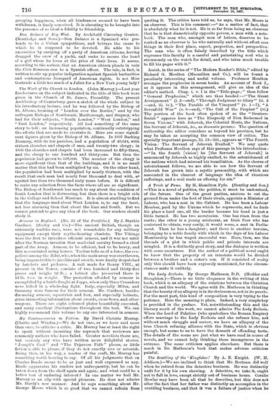Armour in England. (No. 33 of the Portfolio.) By J.
Starkie Gardner. (Seeley and Co.)—The ancient British, though an extremely warlike race, were not remarkable for any military equipment except their scythe-bearing chariots. The Vikings were the first to introduce efficient armour, and it was not until after the Norman invasion that mail-clad cavalry formed a chief part of the Army. Armour, to be efficient, had to be heavy, and this necessitated using horses. Tacitus tells us of a force, the cru- pellarii among the Edui, who, when the main army was overthrown, being impenetrable to javelins and swords, were finally despatched by hatchets and pickaxes. A suit made for Henry VIII., at present in the Tower, consists of two hundred and thirty-five pieces and weighs 92 lb. ; a helmet also preserved there is 13 lb. S oz. in weight. The protection afforded by armour is exemplified by a battle fought at Joppa, when only three Crusaders were killed in a whole-day fight. Italy, especially Milan, and Germany were famous for their armour. Mr. Gardner, besides discussing armour, equestrian and foot, and especially helmets, gives interesting information about swords, cross-bows, and other weapons. There are eight coloured plates beautifully executed, and many excellent illustrations throughout the text. We can highly recommend this volume to any one interested in armour.






















































 Previous page
Previous page